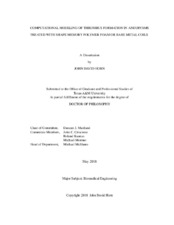| dc.description.abstract | To mitigate the risk of intracranial aneurysm rupture, which can lead to severe debilitation
or death, embolic devices (e.g., bare metal coils or polymeric open-celled foams)
are often delivered via catheter to the aneurysm sac. Hemodynamic perturbations imposed
by the device’s geometry and biochemical interactions between blood in the aneurysm and
the biomaterial surfaces can lead to a clotting response which marks the initial phase of
healing. The ideal outcome of this response to treatment is complete aneurysm occlusion
and isolation from the parent artery to reduce or eliminate the risk of aneurysm rupture.
To compliment in vitro and in vivo device testing, which typically reveals limited
information related to thrombus formation, a computational model which couples biofluid
dynamics and biochemistry has been developed to simulate the transient thrombus formation
within treated aneurysms. The model consists of 28 advection-diffusion-reaction
partial differential equations to track blood proteins involved in clotting. Boundary flux
terms are used to model the initiation of the intrinsic clotting pathway at thrombogenic
device surfaces. This “medium-fidelity” approach is applied to an idealized 2D aneurysm
geometry and the results are compared to predictions produced by a lower-fidelity model
representative of modeling approaches common in the literature for evaluation of device-induced
thrombosis. The latter method uses time-averaged flow features to estimate locations
of clot formation while disregarding physiological and biochemical phenomena.
In contrast, the medium-fidelity model developed in this work is able to represent the
biochemical interactions between blood and biomaterial surfaces and produce transient
predictions of clot growth within the treated aneurysm.
The medium-fidelity model is applied to compare two different aneurysm treatment methods. First, treatment with embolic bare metal coils is simulated. While coils are
the most commonly used devices for aneurysm treatment, their use can often lead to suboptimal
clinical outcomes that can result in aneurysm regrowth. An alternative treatment
method, which is also simulated in this work, is the use of porous shape memory foams.
These foams are delivered though a catheter and can fully expand to fill the aneurysm sac,
providing a scaffold for thrombus growth. The medium-fidelity model is used to predict
the clotting response within aneurysms treated with either method. Overall, the results of
the coil treatments are highly dependent on the random arrangement of coils within the
aneurysm sac and, in many cases, incomplete filling is likely. In contrast, shape memory
polymer foams produce a more uniform and predictable result, independent of the foam
geometry or orientation.
The computational thrombus model, as presented in this dissertation, should be
viewed as an initial iteration of a more complete model. Future work is needed to address
several model limitations, and model validation with experimental data is necessary to
reduce model uncertainty. Nonetheless, the simulations in this work demonstrate the advantages
of the medium-fidelity model approach over low-fidelity models, and they show
the model’s potential as an engineering tool to aid in device design and improve clinical
outcomes. | en |


